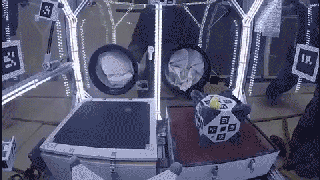Opportunity rover, 12 years old, stuck on a steep hill
Opportunity escaped from the dirt trap, but scientists thought about the possibility of a different design of rovers.

When sending Spirit and Opportunity rovers to Mars, no one expected that these devices could work on the Red Planet for so long. The work program was designed for 3 months, but the rovers worked for years and years. Opportunity lasted longer than the Spirit, and still works. Not so long ago, the rover team celebrated the 12th anniversary of the Mars rover on Mars.
March 31, as reported by NASA, the rover was stuck on a steep hill of Mars, where the project team decided to send a rover to study the terrain features. The slope of the hill turned out to be too steep for the vehicle, the rover could not overcome the angle of 32 degrees. Opportunity was only 9 centimeters, then stuck in the ground. A total of 3 attempts were made to "climb", and all were unsuccessful.

After that, the team decided to send the rover around the hill. This incident, according to agency representatives, shows that wheel systems have limited capabilities. It is better to use other designs.

True, such systems work better in microgravity. NASA engineers have already produced two prototypes of such robots, which were tested under microgravity conditions, on board the C-9 aircraft. The robots of The Hedgehog showed good maneuverability, so the researchers were convinced of the possibility of using such systems on space bodies. At the same time, maneuvers were carried out on various types of surfaces - sand and rock, ice and regolith, soft or elastic surface. To change the position in space in such devices flywheels are used. The planned method of moving probes along the surface of an asteroid is not the most accurate method of movement, but rather effective under such conditions. A robot with a similar principle of action back in 2013 was demonstrated by scientists from Zurich.
Scientists for the first timeWe were able to test the “hedgehogs” in the work, and now the project will be implemented until the creation of a universal robot that can actually be used as a research station. By the way, one of the robots even performed an interesting “tornado” maneuver, during which he began to rotate at high speed, achieving separation from the surface. Such a maneuver can be very useful when hit, for example, in a sand trap or other similar situations.
The cost of creating a "hedgehog" is much lower than the cost of creating, for example, a rover. Scientific tools can be placed inside the device.

When sending Spirit and Opportunity rovers to Mars, no one expected that these devices could work on the Red Planet for so long. The work program was designed for 3 months, but the rovers worked for years and years. Opportunity lasted longer than the Spirit, and still works. Not so long ago, the rover team celebrated the 12th anniversary of the Mars rover on Mars.
March 31, as reported by NASA, the rover was stuck on a steep hill of Mars, where the project team decided to send a rover to study the terrain features. The slope of the hill turned out to be too steep for the vehicle, the rover could not overcome the angle of 32 degrees. Opportunity was only 9 centimeters, then stuck in the ground. A total of 3 attempts were made to "climb", and all were unsuccessful.

After that, the team decided to send the rover around the hill. This incident, according to agency representatives, shows that wheel systems have limited capabilities. It is better to use other designs.

True, such systems work better in microgravity. NASA engineers have already produced two prototypes of such robots, which were tested under microgravity conditions, on board the C-9 aircraft. The robots of The Hedgehog showed good maneuverability, so the researchers were convinced of the possibility of using such systems on space bodies. At the same time, maneuvers were carried out on various types of surfaces - sand and rock, ice and regolith, soft or elastic surface. To change the position in space in such devices flywheels are used. The planned method of moving probes along the surface of an asteroid is not the most accurate method of movement, but rather effective under such conditions. A robot with a similar principle of action back in 2013 was demonstrated by scientists from Zurich.
Scientists for the first timeWe were able to test the “hedgehogs” in the work, and now the project will be implemented until the creation of a universal robot that can actually be used as a research station. By the way, one of the robots even performed an interesting “tornado” maneuver, during which he began to rotate at high speed, achieving separation from the surface. Such a maneuver can be very useful when hit, for example, in a sand trap or other similar situations.
The cost of creating a "hedgehog" is much lower than the cost of creating, for example, a rover. Scientific tools can be placed inside the device.
